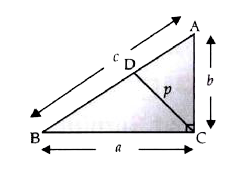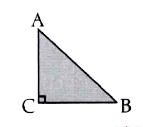ABC is a triangle right angled at C with BC = a and AC = b. If p is the length of the perpendicular from C on AB, then which one of the following is correct ?
a2b2=p2(a2+b2)
a2b2=p2(b2−a2)
2a2b2=p2(a2+b2)
a2b2=2p2(a2+b2)
To solve the problem, we need to find the relationship between the lengths of the sides of the triangle ABC, which is right-angled at C, and the length of the perpendicular from C to the hypotenuse AB.
1. Identify the Triangle:
- We have a right triangle ABC with the right angle at C.
- Let BC = a and AC = b.
2. Use the Pythagorean Theorem:
- According to the Pythagorean theorem, the length of the hypotenuse AB can be calculated as:
AB=√BC2+AC2=√a2+b2
3. Define the Perpendicular:
- Let p be the length of the perpendicular from point C to line AB.
4. Use the Area of the Triangle:
- The area of triangle ABC can be calculated in two ways:
- Using the base and height (where BC is the base and AC is the height):
Area=12×BC×AC=12×a×b
- Using the hypotenuse AB and the height p:
Area=12×AB×p=12×√a2+b2×p
5. Set the Areas Equal:
- Since both expressions represent the area of the same triangle, we can set them equal to each other:
12×a×b=12×√a2+b2×p
6. Simplify the Equation:
- Cancel the 12 from both sides:
a×b=√a2+b2×p
7. Solve for p:
- Rearranging gives us:
p=a×b√a2+b2
8. Square Both Sides:
- To eliminate the square root, we can square both sides:
p2=a2×b2a2+b2
Final Result:
The relationship derived from the above steps is:
p2=a2×b2a2+b2
- We have a right triangle ABC with the right angle at C.
- Let BC = a and AC = b.
- According to the Pythagorean theorem, the length of the hypotenuse AB can be calculated as:
AB=√BC2+AC2=√a2+b2
- Let p be the length of the perpendicular from point C to line AB.
- The area of triangle ABC can be calculated in two ways:
- Using the base and height (where BC is the base and AC is the height):
Area=12×BC×AC=12×a×b
- Using the hypotenuse AB and the height p:
Area=12×AB×p=12×√a2+b2×p
- Since both expressions represent the area of the same triangle, we can set them equal to each other:
12×a×b=12×√a2+b2×p
- Cancel the 12 from both sides:
a×b=√a2+b2×p
- Rearranging gives us:
p=a×b√a2+b2
- To eliminate the square root, we can square both sides:
p2=a2×b2a2+b2
The relationship derived from the above steps is:
p2=a2×b2a2+b2
Similar Questions
Knowledge Check
In a triangle ABC if the angles A, B, C are in AP, then which one of the following is correct ?
Ac = a + bBc2=a2+b2−abCa2=b2+c2−bcDb2=a2+c2−acIn a ΔABC right angle at C .P is the length of ⊥ from C to AB. If a, b, c, are the length of BC , CA, AB. Which relation is correct .
A1p2=1b2−1a2B1p2=1a2+1b2C1p2+1a2=−1b2D1p2=1a2−1b2
ABC is a triangle right angled at C. If AB=25cmandAC=7cm, find BC.
View SolutionABC is a right triangles right angled at C . Let BC =a ,CA=b, AB = c, and p be the length of perpendicular from C to AB . Prove that cp = ab .

View SolutionABC is a triangle right angled at B. If AB=5 cm and BC= 10 cm, then what is the length of the perpendicular drawn from the vertex B to the hypotenuse ?
View SolutionIn Figure ABC is an isosceles triangle right angled at C with AC = 4 cm . Find the length of AB .

View SolutionABC is a triangle right angled at C. Let p be the length of the perpendicular drawn from C on AB. If BC = 6 cm and CA = 8 cm, then what is the value of p ?
View SolutionIn triangle ABC, ∠C=90∘ and CD is the perpendicular from C to AB.
If (CD)−2=(BC)−2+(CA)−2, then which one of the following is correct ?
View Solution
